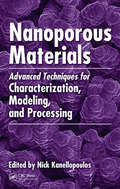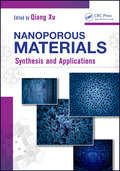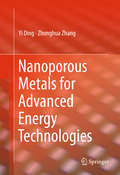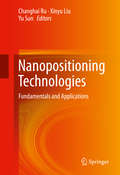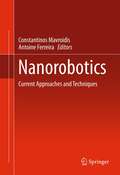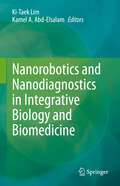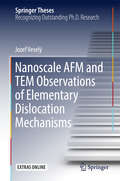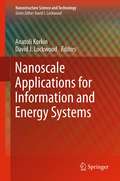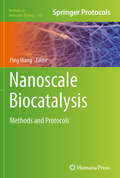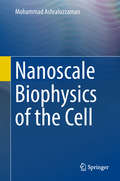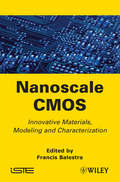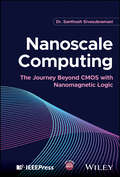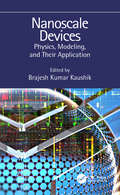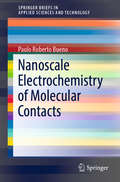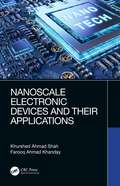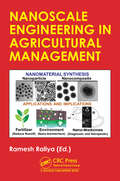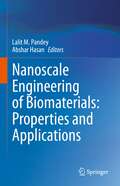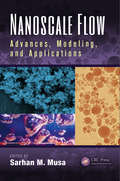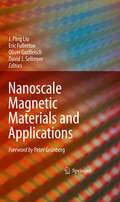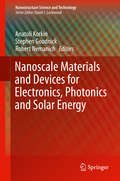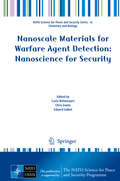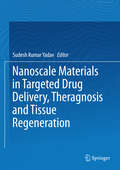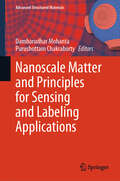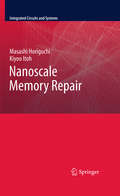- Table View
- List View
Nanoporous Materials: Advanced Techniques for Characterization, Modeling, and Processing
by Nick KanellopoulosHaving successfully replaced elements used in traditional, pollution-prone, energy-consuming separation processes, nanoporous materials play an important role in chemical processing. Although their unique structural or surface physicochemical properties can, to an extent, be tailored to meet specific process-related requirements, the task of charac
Nanoporous Materials: Synthesis and Applications
by Qiang XuIn the past two decades, the field of nanoporous materials has undergone significant developments. As these materials possess high specific surface areas, well-defined pore sizes, and functional sites, they show a great diversity of applications such as molecular adsorption/storage and separation, sensing, catalysis, energy storage and conversion,
Nanoporous Metals for Advanced Energy Technologies
by Yi Ding Zhonghua ZhangThis book covers the state-of-the-art research in nanoporous metals for potential applications in advanced energy fields, including proton exchange membrane fuel cells, Li batteries (Li ion, Li-S, and Li-O2), and supercapacitors. The related structural design and performance of nanoporous metals as well as possible mechanisms and challenges are fully addressed. The formation mechanisms of nanoporous metals during dealloying, the microstructures of nanoporous metals and characterization methods, as well as miscrostructural regulation of nanoporous metals through alloy design of precursors and surface diffusion control are also covered in detail. This is an ideal book for researchers, engineers, graduate students, and government/industry officers who are in charge of R&D investments and strategy related to energy technologies.
Nanopositioning Technologies
by Changhai Ru Xinyu Liu Yu SunThis book covers the state-of-the-art technologies for positioning with nanometer resolutions and accuracies, particularly those based on piezoelectric actuators and MEMS actuators. The latest advances are described, including the design of nanopositioning devices, sensing and actuation technologies and control methods for nanopositioning. This is an ideal book for mechanical and electrical engineering students and researchers; micro and nanotechnology researchers and graduate students; as well as those working in the precision instrumentation or semiconductor industries.
Nanorobotics
by Constantinos Mavroidis Antoine FerreiraNanorobots can be defined as intelligent systems with overall dimensions at or below the micrometer range that are made of assemblies of nanoscale components with individual dimensions ranging between 1 to 100 nm. These devices can now perform a wide variety of tasks at the nanoscale in a wide variety of fields including but not limited to fields such as manufacturing, medicine, supply chain, biology, and aerospace. Nanorobotics: Current Approaches and Techniques offers a comprehensive overview of this emerging interdisciplinary field with a wide ranging discussion that includes nano-manipulation and industrial nanorobotics, nanorobotic manipulation in biology and medicine, nanorobotic sensing, navigation and swarm behavior and CNT, and protein and DNA-based nanorobotics.
Nanorobotics and Nanodiagnostics in Integrative Biology and Biomedicine
by Ki-Taek Lim Kamel A. Abd-ElsalamNanorobotics and Nanodiagnostics in Integrative Biology and Biomedicine "Nanorobotics and nanodiagnostics” can be defined as a new generation of biohybrid and nanorobotics that translate fundamental biological principles into engineering design rules, or integrative living components into synthetic structures to create biorobots and nanodiagnotics that perform like natural systems. Nanorobots or nanobots are structured of a nanoscale made of individual assemblies. They can be termed as intelligent systems manufactured with self-assembly strategies by chemical, physical and biological approaches. The nanorobot can determine the structure and enhance the adaptability to the environment in interdisciplinary tasks."Nanorobotics and nanodiagnostics" is a new generation of biohybrid that translates fundamental biological principles into engineering design rules to create biorobots that perform like natural systems. These biorobotics and diagnostics can now perform various missions to be accomplished certain tasks in the research areas such as integrative biology and biomedicine. "Nanorobotics and Nanodiagnostics in Integrative Biology and Biomedicine" sheds light on a comprehensive overview of the multidisciplinary areas that explore nanotherapeutics and nanorobotic manipulation in biology and medicine. It provides up-to-date knowledge of the promising fields of integrative biology and biomedicine for nano-assisted biorobotics and diagnostics to detect and treat diseases that will enable new scientific discoveries.
Nanosatellites: Space and Ground Technologies, Operations and Economics
by Rogerio Atem de Carvalho Jaime Estela Martin LangerNanosatellites: Space and Ground Technologies, Operations and Economics Rogerio Atem de Carvalho, Instituto Federal Fluminense, Brazil Jaime Estela, Spectrum Aerospace Group, Germany and Peru Martin Langer, Technical University of Munich, Germany Covering the latest research on nanosatellites Nanosatellites: Space and Ground Technologies, Operations and Economics comprehensively presents the latest research on the fast-developing area of nanosatellites. Divided into three distinct sections, the book begins with a brief history of nanosatellites and introduces nanosatellites technologies and payloads, also explaining how these are deployed into space. The second section provides an overview of the ground segment and operations, and the third section focuses on the regulations, policies, economics, and future trends. Key features: Payloads for nanosatellites Nanosatellites components design Examines the cost of development of nanosatellites. Covers the latest policies and regulations. Considers future trends for nanosatellites. Nanosatellites: Space and Ground Technologies, Operations and Economics is a comprehensive reference for researchers and practitioners working with nanosatellites in the aerospace industry.
Nanoscale AFM and TEM Observations of Elementary Dislocation Mechanisms
by Jozef VeselýThis thesis addresses elementary dislocation processes occurring in single-crystalline alloys based on Fe-Al, and investigates correspondences between dislocation distribution inside crystals characterized by transmission electron microscopy (TEM) and surface patterns observed using atomic force microscopy (AFM). Fe-Al alloys with different degrees of ordering were prepared and deformed in compression at ambient temperature in-situ inside the AFM device. The evolution of slip line structures was captured in the sequences of AFM images and wavy slip bands, while cross slip at the tip of the slip band and homogeneous fine slip lines were also identified. Further, the thesis develops a technique for constructing 3D representations of dislocations observed by TEM without the prohibitive difficulties of tomography, and creates 3D models of dislocation structures. Generally speaking, the thesis finds good agreement between AFM and TEM observations, confirming the value of AFM as a relevant tool for studying dislocations.
Nanoscale Applications for Information and Energy Systems
by Anatoli Korkin David J. LockwoodNanoscale Applications for Information and Energy Systems presents nanotechnology fundamentals and applications in the key research areas of information technology (electronics and photonics) and alternative (solar) energy: plasmonics, photovoltaics, transparent conducting electrodes, silicon electroplating, and resistive switching. The three major technology areas - electronics, photonics, and solar energy - are linked on the basis of similar applications of nanostructured materials in research and development. By bridging the materials physics and chemistry at the atomic scale with device and system design, integration, and performance requirements, tutorial chapters from worldwide leaders in the field provide a coherent picture of theoretical and experimental research efforts and technology development in these highly interdisciplinary areas.
Nanoscale Biocatalysis
by Ping WangNanoscale science and engineering, which deal with size-dependent properties and phenomenon at nanometer scale, are unveiling new mechanisms that scientists must rely on heavily at the present time to achieve efficient and sustainable chemical processing technologies. In Nanoscale Biocatalysis: Methods and Protocols, expert researchers in the field contribute detailed methodologies and procedures that have been developed from recent research in this burgeoning area of nanoscale technology-enabled biocatalysis. The volume opens with concepts in preparing unique and dynamic protein structures for biocatalysis, then moves on to cover methods for preparation of enzyme assembles or complexes that maintain molecular-like Brownian mobility, the development of protein-nanostructure complexes using carbon nanotubes (CNTs) and nanoparticles, as well as methodologies that have great potential for scale-up preparation of nano-structured biocatalysts. Written in the highly successful Methods in Molecular BiologyTM series format, chapters include brief introductions to their respective topics, lists of the necessary materials and reagents, step-by-step, readily reproducible laboratory protocols, and vital tips on troubleshooting and avoiding known pitfalls. Authoritative and cutting-edge, Nanoscale Biocatalysis: Methods and Protocols is an ideal guide to the new wave of development in nearly all the major areas of science and engineering brought about by this fascinating and greatly promising area of study.
Nanoscale Biophysics of the Cell
by Mohammad AshrafuzzamanMacroscopic cellular structures and functions are generally investigated using biological and biochemical approaches. But these methods are no longer adequate when one needs to penetrate deep into the small-scale structures and understand their functions. The cell is found to hold various physical structures, molecular machines, and processes that require physical and mathematical approaches to understand and indeed manipulate them. Disorders in general cellular compartments, perturbations in single molecular structures, drug distribution therein, and target specific drug-binding, etc. are mostly physical phenomena. This book will show how biophysics has revolutionized our way of addressing the science and technology of nanoscale structures of cells, and also describes the potential for manipulating the events that occur in them.
Nanoscale CMOS: Innovative Materials, Modeling and Characterization (Wiley-iste Ser.)
by Francis BalestraThis book provides a comprehensive review of the state-of-the-art in the development of new and innovative materials, and of advanced modeling and characterization methods for nanoscale CMOS devices. Leading global industry bodies including the International Technology Roadmap for Semiconductors (ITRS) have created a forecast of performance improvements that will be delivered in the foreseeable future – in the form of a roadmap that will lead to a substantial enlargement in the number of materials, technologies and device architectures used in CMOS devices. This book addresses the field of materials development, which has been the subject of a major research drive aimed at finding new ways to enhance the performance of semiconductor technologies. It covers three areas that will each have a dramatic impact on the development of future CMOS devices: global and local strained and alternative materials for high speed channels on bulk substrate and insulator; very low access resistance; and various high dielectric constant gate stacks for power scaling. The book also provides information on the most appropriate modeling and simulation methods for electrical properties of advanced MOSFETs, including ballistic transport, gate leakage, atomistic simulation, and compact models for single and multi-gate devices, nanowire and carbon-based FETs. Finally, the book presents an in-depth investigation of the main nanocharacterization techniques that can be used for an accurate determination of transport parameters, interface defects, channel strain as well as RF properties, including capacitance-conductance, improved split C-V, magnetoresistance, charge pumping, low frequency noise, and Raman spectroscopy.
Nanoscale Computing: The Journey Beyond CMOS with Nanomagnetic Logic
by Santhosh SivasubramaniUnderstand the future of computing with this accessible, wide-ranging introduction to a promising field Miniaturization and the emergence of nanotechnology have together constituted the most revolutionary development in recent decades of computing research and innovation. Nanomagnetic computing and logic have allowed engineers and programmers to move beyond the Complementary Metal-Oxide-Semiconductor (CMOS) and their associated methods into a new world of cutting-edge computing technology. Nanoscale Computing offers the first-ever single-authored textbook on this vital subject, introducing the fundamentals of nanoscale computing, their suitability to the traditional limitations of CMOS computing, and their growing number of applications. The result is a key text for students, professionals, and researchers alike. Nanoscale Computing readers will also find: An emphasis on practical applications, both current and future Detailed discussion of topics including nanomagnetic logic, edge computing, and more End of chapter quizzes and additional tutorials to facilitate learning Nanoscale Computing is ideal for researchers and technology experts, as well as graduate and undergraduate students working in computer science, nanotechnology, magnetics, electronics, semiconductors, electron devices, circuits/systems, and multi-interdisciplinary related fields.
Nanoscale Devices: Physics, Modeling, and Their Application
by Brajesh Kumar KaushikThe primary aim of this book is to discuss various aspects of nanoscale device design and their applications including transport mechanism, modeling, and circuit applications. . Provides a platform for modeling and analysis of state-of-the-art devices in nanoscale regime, reviews issues related to optimizing the sub-nanometer device performance and addresses simulation aspect and/or fabrication process of devices Also, includes design problems at the end of each chapter
Nanoscale Electrochemistry of Molecular Contacts (SpringerBriefs in Applied Sciences and Technology)
by Paulo Roberto BuenoThis book discusses the merging of nanoscale electronics and electrochemistry and how this can potentially modernize the way electronic devices are currently engineered or constructed. It introduces the electrochemical capacitance as a fundamental missing concept that solves the puzzle between molecular electronics and electrochemistry at the nanoscale. The electrochemical capacitance, as a fundamental principle, is deduced from first principles quantum mechanics. The text also confirmed that faradaic and non-faradaic processes are only different physical approximations of the same sort of energetic phenomenon.The book comprises three chapters. Chapter one introduces the concepts of chemical capacitance, relaxation resistance, and the quantum resistive-capacitive circuit and demonstrates how these elements are translated to the electrochemistry context. In chapter two, the chemical capacitance, the fundamental concept and missing part of the puzzle that unity electronics and electrochemistry, is deduced from first principles of quantum mechanics. In chapter three, the concepts are practically used in different contexts that include molecular diagnostics, molecular conductance and super-capacitive phenomena is explained using the introduced basic principles.
Nanoscale Electronic Devices and Their Applications
by Khurshed Ahmad Shah Farooq Ahmad KhandayNanoscale Electronic Devices and Their Applications helps readers acquire a thorough understanding of the fundamentals of solids at the nanoscale level in addition to their applications including operation and properties of recent nanoscale devices. This book includes seven chapters that give an overview of electrons in solids, carbon nanotube devices and their applications, doping techniques, construction and operational details of channel-engineered MOSFETs, and spintronic devices and their applications. Structural and operational features of phase-change memory (PCM), memristor, and resistive random-access memory (ReRAM) are also discussed. In addition, some applications of these phase-change devices to logic designs have been presented. Aimed at senior undergraduate students in electrical engineering, micro-electronics engineering, physics, and device physics, this book: Covers a wide area of nanoscale devices while explaining the fundamental physics in these devices Reviews information on CNT two- and three-probe devices, spintronic devices, CNT interconnects, CNT memories, and NDR in CNT FETs Discusses spin-controlled devices and their applications, multi-material devices, and gates in addition to phase-change devices Includes rigorous mathematical derivations of the semiconductor physics Illustrates major concepts thorough discussions and various diagrams
Nanoscale Engineering in Agricultural Management
by Ramesh RaliyaAgriculture plays a vital role in our lives, providing food and economic benefits. Today, it faces severe challenges, due to decreasing arable land, depleting natural resources, changing climate pattern, and yet increasing demand for food. The recent introduction of nanotechnology in agriculture offers sustainable and precise solutions for developing smart agriculture practices and addressing the challenges faced by the ag-sector. Therefore, it is essential to understand this new science from a multidimensional perspective. Experts in the field have contributed in putting together this volume, covering topics like plant growth, protection and management using engineering nanoscale materials. The chapters in the book have been peer-reviewed and selected for publication based on independent reviewers’ reports. The book covers very specific, in-depth, and fundamental and applied aspects of the latest ag-nanotechnology research. It is hoped that each chapter of the book will be very useful for researchers, policy makers, and other audiences from interdisciplinary scientific subjects.
Nanoscale Engineering of Biomaterials: Properties and Applications
by Lalit M. Pandey Abshar HasanThis book provides a comprehensive overview of the latest advances in a wide range of biomaterials for the development of smart and advanced functional materials. It discusses the fundamentals of bio-interfacial interactions and the surface engineering of emerging biomaterials like metals and alloys, polymers, ceramics, and composites/nanocomposites. In turn, the book addresses the latest techniques and approaches to engineering material surfaces/interfaces in, e.g., implants, tissue engineering, drug delivery, antifouling, and dentistry. Lastly, it summarizes various challenges in the design and development of novel biomaterials. Given its scope, it offers a valuable source of information for students, academics, physicians and particularly researchers from diverse disciplines such as material science and engineering, polymer engineering, biotechnology, bioengineering, chemistry, chemical engineering, nanotechnology, and biomedical engineering for various commercial and scientific applications.
Nanoscale Flow: Advances, Modeling, and Applications
by Sarhan M. MusaUnderstanding the physical properties and dynamical behavior of nanochannel flows has been of great interest in recent years and is important for the theoretical study of fluid dynamics and engineering applications in physics, chemistry, medicine, and electronics. The flows inside nanoscale pores are also important due to their highly beneficial drag and heat transfer properties. Nanoscale Flow: Advances, Modeling, and Applications presents the latest research in the multidisciplinary area of nanoscale flow. Featuring contributions from top inventors in industry, academia, and government, this comprehensive book: Highlights the current status of research on nucleate pool boiling heat transfer, flow boiling heat transfer, and critical heat flux (CHF) phenomena of nanofluids Describes two novel fractal models for pool boiling heat transfer of nanofluids, including subcooled pool boiling and nucleate pool boiling Explores thermal conductivity enhancement in nanofluids measured with a hot-wire calorimeter Discusses two-phase laminar mixed convection AL2O3–water nanofluid in an elliptic duct Explains the principles of molecular and omics imaging and spectroscopy techniques for cancer detection Analyzes fluid dynamics modeling of the tumor vasculature and drug transport Studies the properties of nanoscale particles and their impact on diagnosis, therapeutics, and theranostics Provides a brief background and review of medical nanoscale flow applications Contains useful appendices of physical constants, equations, common symbols, mathematical formulas, the periodic table, and more A valuable reference for engineers, scientists, and biologists, Nanoscale Flow: Advances, Modeling, and Applications is also designed for researchers, universities, industrial institutions, and government, giving it broad appeal.
Nanoscale Magnetic Materials and Applications
by Oliver Gutfleisch J. Ping Liu D. J. Sellmyer Eric FullertonNanoscale Magnetic Materials and Applications covers exciting new developments in the field of advanced magnetic materials. Readers will find valuable reviews of the current experimental and theoretical work on novel magnetic structures, nanocomposite magnets, spintronic materials, domain structure and domain-wall motion, in addition to nanoparticles and patterned magnetic recording media. Cutting-edge applications in the field are described by leading experts from academic and industrial communities. These include new devices based on domain wall motion, magnetic sensors derived from both giant and tunneling magnetoresistance, thin film devices in micro-electromechanical systems, and nanoparticle applications in biomedicine. In addition to providing an introduction to the advances in magnetic materials and applications at the nanoscale, this volume also presents emerging materials and phenomena, such as magnetocaloric and ferromagnetic shape memory materials, which motivate future development in this exciting field. Nanoscale Magnetic Materials and Applications also features a foreword written by Peter Grünberg, recipient of the 2007 Nobel Prize in Physics.
Nanoscale Materials and Devices for Electronics, Photonics and Solar Energy
by Anatoli Korkin Stephen Goodnick Robert NemanichThis book presents research dedicated to solving scientific and technological problems in many areas of electronics, photonics and renewable energy. Progress in information and renewable energy technologies requires miniaturization of devices and reduction of costs, energy and material consumption. The latest generation of electronic devices is now approaching nanometer scale dimensions; new materials are being introduced into electronics manufacturing at an unprecedented rate; and alternative technologies to mainstream CMOS are evolving. The low cost of natural energy sources have created economic barriers to the development of alternative and more efficient solar energy systems, fuel cells and batteries. Nanotechnology is widely accepted as a source of potential solutions in securing future progress for information and energy technologies. Nanoscale Materials and Devices for Electronics, Photonics and Solar Energy features chapters that cover the following areas: atomic scale materials design, bio- and molecular electronics, high frequency electronics, fabrication of nanodevices, magnetic materials and spintronics, materials and processes for integrated and subwave optoelectronics, nanoCMOS, new materials for FETs and other devices, nanoelectronics system architecture, nano optics and lasers, non-silicon materials and devices, chemical and biosensors,quantum effects in devices, nano science and technology applications in the development of novel solar energy devices, and fuel cells and batteries.
Nanoscale Materials for Warfare Agent Detection: Nanoscience for Security (NATO Science for Peace and Security Series A: Chemistry and Biology)
by Carla Bittencourt Chris Ewels Eduard LlobetThis book presents a blueprint for researchers in the area of nanotechnology for chemical defense, especially with regard to future research on detection and protection. It addresses the synthesis of complex nanomaterials with potential applications in a broad range of sensing systems. Above all, it discusses novel experimental and theoretical tools for characterizing and modeling nanostructures and their integration in complex systems. The book also includes electronic structure calculations exploring the atomic and quantum mechanical mechanisms behind molecular binding and identification, so as to provide readers with an in-depth understanding of the capabilities and limitations of various nanomaterial approaches. Gathering contributions by scientists with diverse backgrounds, the book offers a wealth of insightful information for all scientists whose work involves material science and its applications in sensing.
Nanoscale Materials in Targeted Drug Delivery, Theragnosis and Tissue Regeneration
by Sudesh Kumar YadavThis book is the first of its kind to offer a comprehensive and up-to-date discussion of the use of nanoscale materials for biomedical applications, with a particular focus on drug delivery, theragnosis and tissue regeneration. It also describes in detail the methods used in the preparation of nanoparticles. Response of nanoparticles in biological systems are also explored. Nanotechnology has led to the advent of a new field, nanomedicine, which focuses on the use of nanomaterials as drug-delivery vehicles to develop highly selective and effective drugs. The combination of molecular imaging and nanotechnology has produced theragnostic nanoparticles, which allow the simultaneous detection and monitoring of diseases. Nanotechnology can also be combined with biomaterials to create scaffolds for tissue regeneration. Further, significant advances have been made in the areas of drug delivery, theragnostic nanoparticles and tissue regeneration materials. Some nanomedicines and tissue regeneration materials are already commercially available, while others are undergoing clinical trials, and promising results have been documented. Despite the rapid advances in nanomedicine, there is a relative dearth of literature on the biomedical applications of nanoscale materials.
Nanoscale Matter and Principles for Sensing and Labeling Applications (Advanced Structured Materials #206)
by Dambarudhar Mohanta Purushottam ChakrabortyThis book is a compilation of carefully chosen chapters that cover the subjects of nanoscale matter, sensing, and labelling applications. It is aimed primarily at scientists and researchers who are already involved in theme-based research or who are just starting their careers. Despite the diverse nature of the topics covered, which include a range of materials in various forms and uses, the emphasis is primarily on sensing and labelling phenomena. The book begins with materials quantification in nanoscale systems by using an innovative technique like “molecular secondary ion mass spectrometry without calibration standards”. Subsequently, the book features an array of materials such as inorganic semiconductor nanoscale particles, carbon dots, rare-earth oxides, polymer nanocomposites, and a few biomaterials, all of which illustrate their functionality and potential for deployment in a wide variety of sensing applications. Although the book delves into the technical aspects of fabrication workouts to some extent, the focus is predominantly on the physical principles, mechanisms, and relevance involved in sensing and labelling applications. The book covers a wide range of topics that leverage the unique properties of nanoscale materials. By carefully selecting appropriate active materials, the authors explore the detection of LPG, hazardous and explosive gases, as well as humidity sensing and hydrogen evolution. It also delves into photo-sensing and persistent photoconductivity by using nanoscale semiconductors, which are used for heavy metal sensing and UV sensing, respectively. The use of metal nanoparticles in various forms is reviewed to address issues related to water contamination, biofilm protection, and food-borne pathogens. The book also discusses surface plasmon resonance, starting with its basic principles and expanding to its relevance in a broader perspective, with a greater focus on applied biosensing. Nanoscale ferrites and magnetic systems are explored with an emphasis on magnetic sensing and actuation. Lastly, the book explores the use of rare-earth-based nanosystems, highlighting persistent luminescence and up/down-converted transitions, which have unprecedented applications in bioimaging and biolabeling. Every effort has been made to strike a balance between the observed phenomena in the emerging areas of sensing applications and suitable theoretical treatments there in.
Nanoscale Memory Repair
by Masashi Horiguchi Kiyoo ItohYield and reliability of memories have degraded with device and voltage scaling in the nano-scale era, due to ever-increasing hard/soft errors and device parameter variations. This book systematically describes these yield and reliability issues in terms of mathematics and engineering, as well as an array of repair techniques, based on the authors' long careers in developing memories and low-voltage CMOS circuits. Nanoscale Memory Repair gives a detailed explanation of the various yield models and calculations, as well as various, practical logic and circuits that are critical for higher yield and reliability.
